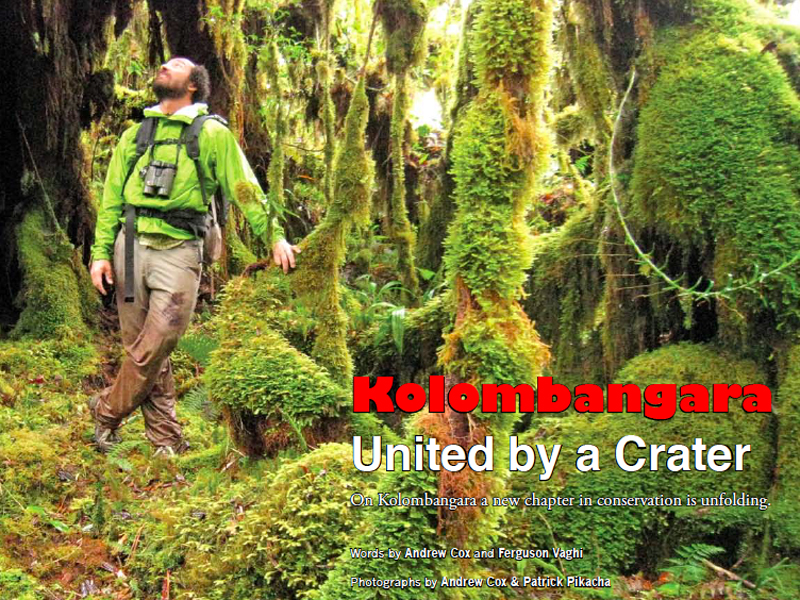About the 400m conservation area
Conservation Efforts of the Kolombangara People and the Forests Above 400m Altitude
- KIBCA was formed in 2008 and represents the conservation interests of Kolombangara landowners.
- In 2008 and 2009, all landowners on Kolombangara Island signed a Community Conservation Agreement that promised they would not log or mine above 400m altitude
- This area above 400m altitude can therefore be regarded as a conservation area and covers an area of 20,000 hectares or 200 square km.
- On 15 and 16 June 2011, Solomon Islands Prime Minister, Danny Philip, and Minister of Environment, Moffet Fugui, dedicated the conservation area above 400m at a ceremony at Ringgi as part of the Kolombangara Island Biodiversity and Cultural Festival. This makes it the largest conservation area in the Solomon Islands.
Kolombangara: United by a Crater
Read coverage (pdf 1Mb) by Melanesian Geo about the conservation efforts on Kolombangara Island in a six-page feature with stunning photos. Text by Andrew Cox and Ferguson Vaghi, photos by Patrick Pikacha and Andrew Cox. See the end of the page to download the story as a separate file.
About the 400m Conservation Area
- The conservation area covers 28% of Kolombangara Island and is the largest conservation area in the Solomon Islands.
- The conservation area covers the three highest peaks of Kolombangara Island, Mt Rano 1,698m, Mt Tepalamenggatu 1,708m and Mt Veve 1,779m and all of the Kolombangara Island volcano.
- KIBCA manages the conservation area on behalf of KFPL and Kolombangara landholders
Importance of the 400m Conservation Area
- The 400m conservation area protects many important plants and animals and important cultural sites of the Kolombangara people.
- At 400m the lowland and hill forests overlap, resulting in rich numbers of plant and animal species.
- Above 400m altitude, and in particular along the higher ridgelines, there is greater endemism (meaning there are more plants or animals that are found only in that place).
- The conservation area has endemic birds like the Kolombangara white-eye (Zosterops murphyi) and Kolombangara leaf warbler (Phylloscopus amoenus) found nowhere else on Earth.
- The conservation area also has mountain specialists like the blue faced parrot finches (Erythrura trichroa), Meek’s lorikeet (Charmosyna meeki), red-breasted pygmy parrots (Micropsitta bruijnii), and pale mountain pigeons (Gymnophaps solomonensis) that are restricted to the high ridgelines and slopes.
- A new species of frog was discovered above 1,600m altitude when two individuals were captured in 2010 and at least two other unknown species were heard calling high in the mossy vegetation at this site. There are likely to be other new species in the conservation area.
- The conservation area protects the headwaters of at least 80 major rivers and streams that all coastal villages of Kolombangara rely on for clean and reliable water. This is the reason that Kolombangara is commonly known as the Water Lord or Water King.
- Most of the cultural sites of the Kolombangara people are found above 400m altitude
Threats to the 400m Conservation Area
- The disappearance of biodiversity on Kolombangara Island and elsewhere in the Solomon Islands, poses a real threat to important animal and plant species and the country’s natural heritage, and to the survival of forest dependent communities.
- Industrial-scale logging that is unsustainable and forest clearing for farming and villages threatens biodiversity and cultural sites on the island. Mining may be a future threat.
- KIBCA aims to help landholders protect the conservation area so that its plant and animals can continue to survive for many more hundreds of years and that its cultural sites are preserved.
Acknowledgements:Biological information was obtained from Biodiversity of the Crater Area & surrounding mountain forests, Kolombangara Island by Patrick Pikacha & Myknee Sirikolo, draft report Nov 2010, WWF Melanesia.



Recent comments